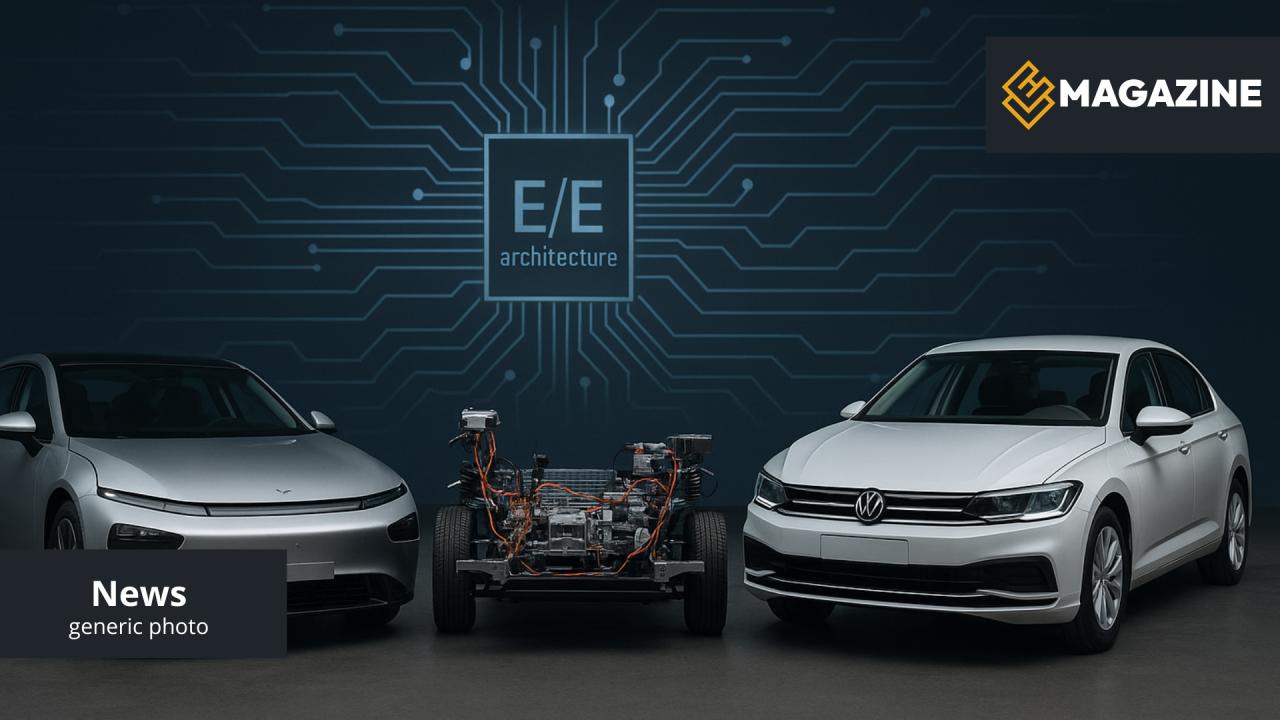30%
24
40
3
China Electrical Architecture: The Foundation of Tomorrow's Vehicles
The China Electrical Architecture (CEA) represents a quantum leap in automotive technology, introducing a revolutionary zonal E/E architecture that fundamentally reimagines how vehicles process information and execute commands. This jointly developed system between XPeng, Volkswagen China Technology Company (VCTC), and CARIAD China transcends traditional boundaries by creating a unified digital nervous system applicable across all powertrain types.
Unlike conventional distributed systems with numerous isolated control units, the CEA employs a sophisticated zonal structure where three powerful central computers orchestrate all vehicle functions. Each zone controller manages specific vehicle regions, communicating through high-speed data highways that enable real-time coordination and instantaneous over-the-air updates. This architectural transformation slashes system complexity while exponentially increasing computational capacity for advanced features like autonomous driving and AI-powered driver assistance.
Strategic Partnership Evolution Timeline
Technical Excellence: Core Capabilities
Three high-performance central computers replace traditional distributed ECUs, creating a unified command center that processes data at unprecedented speeds while maintaining fail-safe redundancy.
Continuous software enhancement capabilities enable real-time feature additions, performance optimizations, and security patches without dealership visits, fundamentally changing the ownership experience.
Native support for advanced autonomous driving systems, intelligent voice assistants, and predictive maintenance algorithms positions vehicles for future technological breakthroughs.
Revolutionary platform-oriented design enables seamless deployment across BEV, ICE, and PHEV vehicles, maximizing economies of scale while maintaining powertrain-specific optimizations.
The Expanded Technical Collaboration marks a significant milestone in the ongoing strategic collaboration between XPENG and the Volkswagen Group. This not only underscores the mutual trust in our long-term strategic partnership but also highlights our commitment to and vision for continuous innovation in smart electric vehicle technologies.
Market Impact: Reshaping China's Automotive Landscape
The CEA enables what industry insiders call "China Speed" development—cutting traditional vehicle development cycles from 48-60 months to just 24 months for new models. This dramatic acceleration allows manufacturers to respond to market trends in real-time, introducing features that would typically require model year updates through simple software deployments.
Cost Revolution: By consolidating electronic control units and standardizing the architecture across multiple platforms, the partnership achieves an estimated 40% cost reduction compared to traditional European-developed platforms. This efficiency translates directly to more competitive pricing for consumers while maintaining premium features.
Local Ecosystem Integration: The architecture's open design philosophy enables seamless integration with China's vibrant technology ecosystem, including partnerships with companies like Horizon Robotics for AI chips and ThunderSoft for software development, creating a truly localized solution that resonates with Chinese consumer preferences.
Vehicle Deployment Strategy
Innovation Focus: First vehicles to showcase full CEA capabilities with advanced ADAS and intelligent cockpit functions.
Innovation Focus: Bringing software-defined vehicle benefits to traditional powertrains, enabling consistent digital experiences across entire portfolio.
Project House: Innovation at China Speed
The establishment of dedicated Project Houses in Guangzhou and Hefei represents a new collaborative model where XPeng and Volkswagen engineers work side-by-side, breaking down traditional corporate barriers. This integrated approach has already yielded remarkable results, compressing typical architecture development timelines by over 50%.
We do not confine technological excellence to a single powertrain type. By extending the China Electronic Architecture to our robust combustion engine fleet, we are strengthening our technological leadership in the conventional powertrain sector while systematically reducing our cost base.
Future Implications: Beyond 2026
The CEA architecture establishes the foundation for vehicles that evolve continuously throughout their lifecycle. Features once locked at the point of manufacture—from driving dynamics to entertainment capabilities—become fluid, upgradeable elements that improve with age rather than depreciate.
While initially China-focused, the architecture's success could influence Volkswagen's global strategy, potentially extending to European and North American markets by 2027-2028.
Remote diagnostics and predictive maintenance capabilities reduce service center visits by up to 60%, while enabling proactive component replacement before failures occur.
On-demand feature activation allows customers to temporarily or permanently unlock capabilities like enhanced acceleration, advanced driver assistance, or premium infotainment services.
Built-in capacity for Level 4 and potentially Level 5 autonomous driving ensures vehicles remain technologically relevant as regulatory frameworks evolve.
Industry Analysis: Competitive Landscape Transformation
The collaboration challenges established industry norms where automakers typically guard their core technologies zealously. By combining XPeng's software expertise with Volkswagen's manufacturing scale and engineering heritage, the partnership creates a formidable competitor to both Tesla's integrated approach and traditional luxury brands' incremental evolution strategies.
Market analysts project that vehicles equipped with the CEA architecture could capture 15-20% of China's premium vehicle segment by 2028, representing approximately 2.5 million units annually. This success could trigger industry-wide adoption of similar collaborative models, fundamentally restructuring how automotive companies approach technology development.

